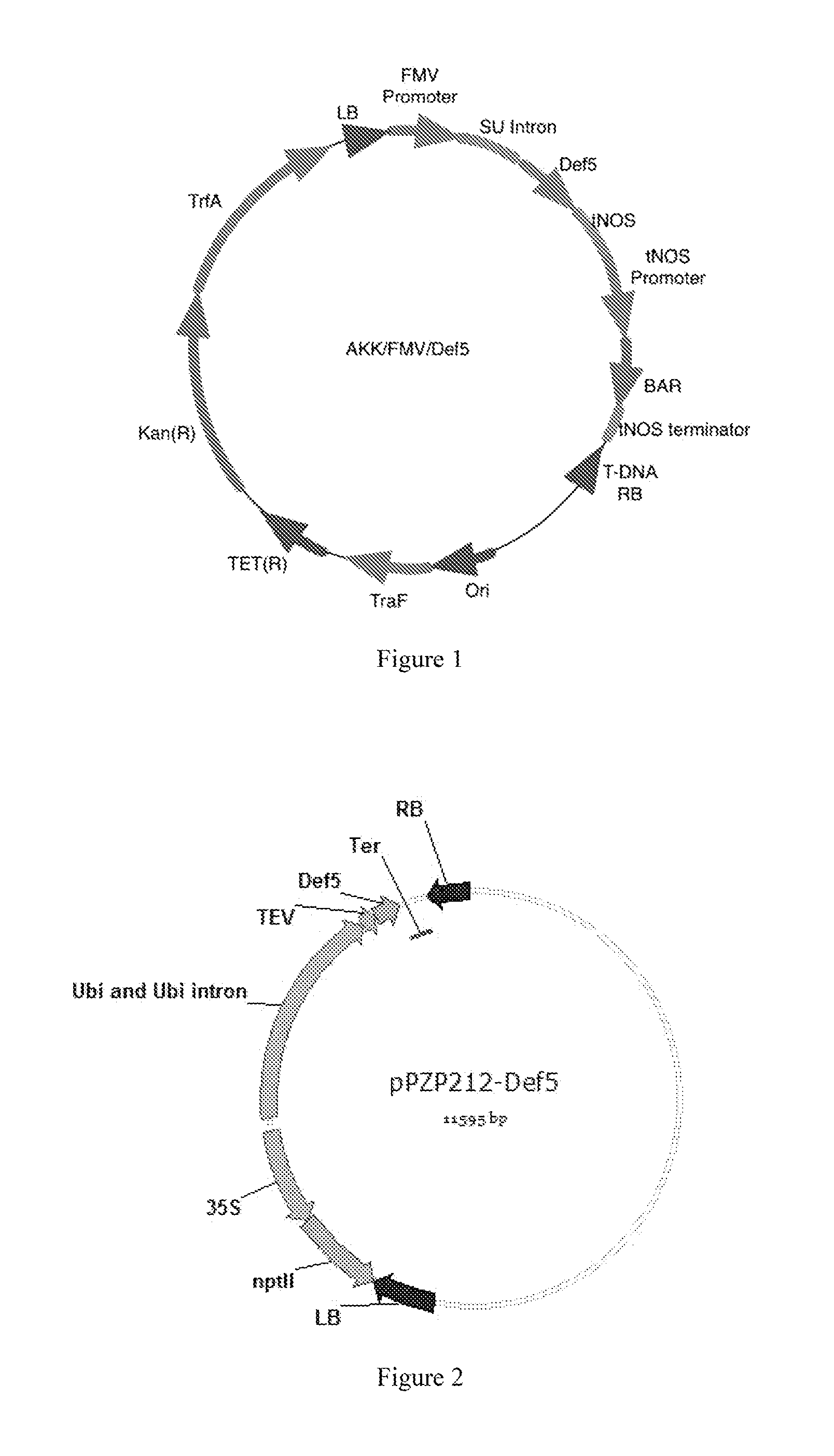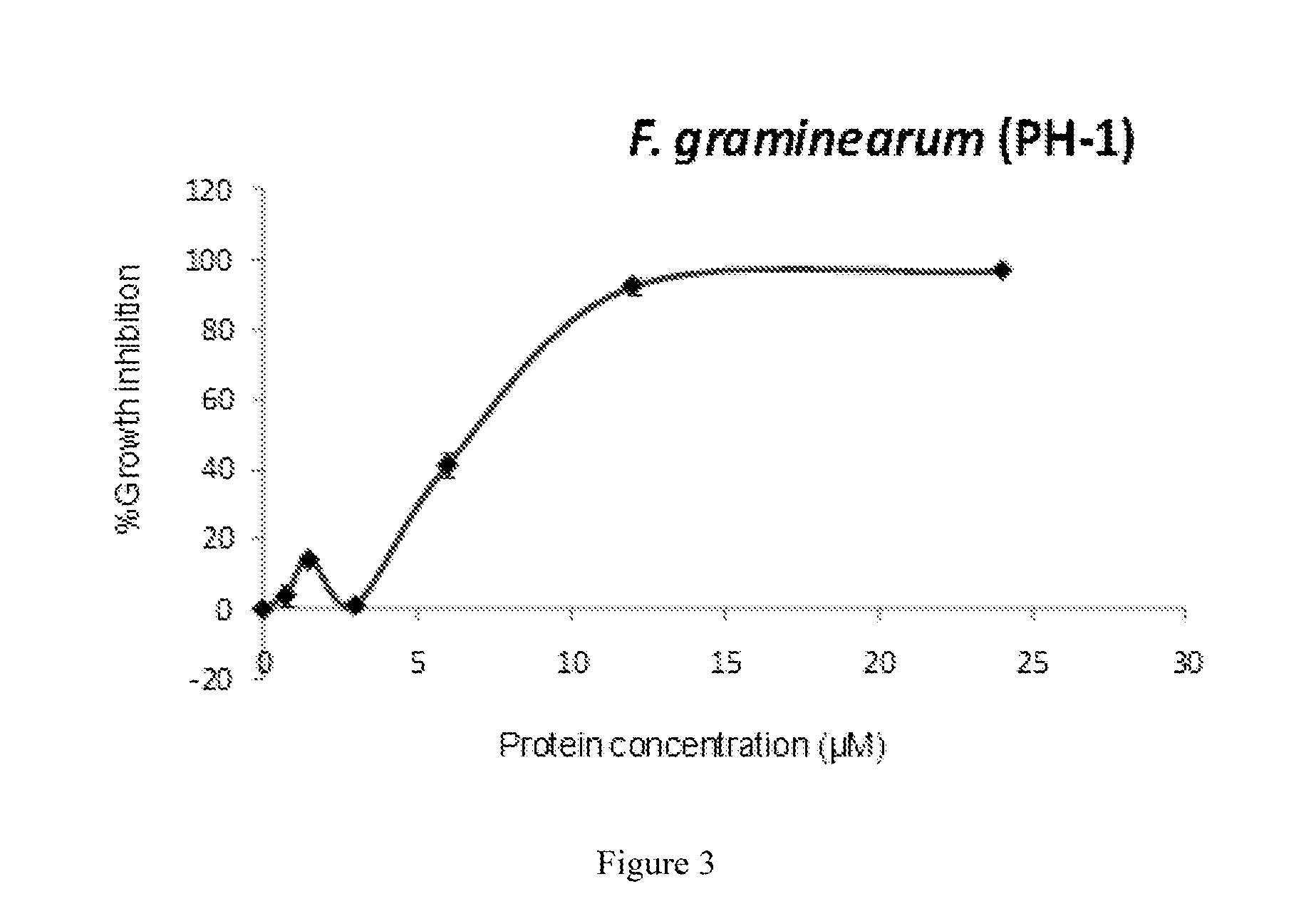Antifungal Plant Proteins, Peptides, And Methods Of Use
a technology of plant proteins and peptides, applied in the direction of peptides, plant/algae/fungi/lichens ingredients, drug compositions, etc., can solve the problems of spoilage and contamination of food or feed products with fungal toxins, failure to deliver adequate protection, and complicated control of plant pathogens
- Summary
- Abstract
- Description
- Claims
- Application Information
AI Technical Summary
Benefits of technology
Problems solved by technology
Method used
Image
Examples
example 1
Construction of Soybean Transformation Vector AKK / FMV / MtDef5
[0365]As shown in FIG. 1, a MtDef5 gene or cDNA with its own signal peptide is cloned as a Nco I-Xba I fragment between the Figwort mosaic virus 35S promoter (Sanger et al. (1990) Plant Molecular Biology 14:433-443) and nopaline synthase polyadenylation signal (Gleave (1992) Plant Molecular Biology 20:1203-1207) in the soybean expression vector AKK1472 (Hammes et al. (2005) Molecular Plant Microbe Interactions 18:1247-1257). The AKK1472 vector containing a MtDef5 chimeric gene or cDNA and bar gene conferring Basta® resistance as a selectable marker gene (Thompson et al. (1985) EMBO Journal 6:2519-2523) is transferred to Agrobacterium tumefaciens strain EHA105 for soybean transformation (Clemente et al. (2000) Crop Sci. 40:797-803; Zhang et al. (1999) Plant Cell, Tiss. Organ Cult. 56:37-46).
example 2
Soybean Transformation and Regeneration of Transgenic Plants
[0366]The transformation protocol used in this example to create transgenic soybean lines using Agrobacterium has been previously described (Clemente et al. (2000) Crop Sci. 40:797-803; Zhang et al. (1999) Plant Cell, Tiss. Organ Cult. 56:37-46).
[0367]The exterior of the seeds (in this case the soybean variety called “Jack”) are first sterilized using commercial grade Clorox® (5% aqueous sodium hypochlorite, NaClO) overnight. The sterilized seeds are then allowed to germinate in germination medium (GM; Gamborg's B5 medium (Gamborg et al. (1968) Experimental Cell Research 50:151) supplemented with 2% sucrose, pH 5.8, solidified with 0.8% agar) for 5 days at 24° C. (18 / 6) light regime). The A. tumefaciens transformed with the vector of Example 1 are collected via low speed centrifugation and suspended in co-cultivation medium to a final OD650 of 0.6 to 1.0. Co-cultivation medium is 1 / 10th Gamborg's B5 medium supplemented with...
example 3
Construction of Wheat Transformation Vector pZP212 / Maize Ubi1A Promoter / MtDef5 / 35S 3′
[0372]For expression of MtDef5 in wheat, a MtDef5 gene or cDNA will be synthesized based on monocot preferred codons such that the amino acid sequence of the MtDef5 signal peptide and mature protein remain unchanged. The synthetic MtDef5 gene or cDNA will be obtained from the GenScript Corporation (Piscataway, N.J., USA). The synthetic MtDef5 gene will be placed between the maize ubiquitin (Ubi1) promoter / intron and CaMV 35S polyadenylation signal sequence and cloned between the T-DNA borders of the binary plant expression vector pZP212 (Hajdukiewicz et al., 1994) as shown in FIG. 2.
[0373]The pZP212 vector containing the synthetic MtDef5 gene or cDNA and a neomycin phosphotransferase selectable marker gene (nptII) will be introduced into Bobwhite and / or XC9 wheat. The transgenic wheat will be obtained as described below in Example 4.
PUM
| Property | Measurement | Unit |
|---|---|---|
| Fraction | aaaaa | aaaaa |
Abstract
Description
Claims
Application Information
 Login to View More
Login to View More - R&D
- Intellectual Property
- Life Sciences
- Materials
- Tech Scout
- Unparalleled Data Quality
- Higher Quality Content
- 60% Fewer Hallucinations
Browse by: Latest US Patents, China's latest patents, Technical Efficacy Thesaurus, Application Domain, Technology Topic, Popular Technical Reports.
© 2025 PatSnap. All rights reserved.Legal|Privacy policy|Modern Slavery Act Transparency Statement|Sitemap|About US| Contact US: help@patsnap.com



